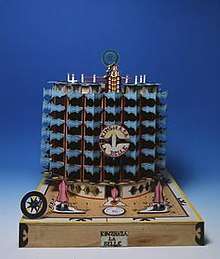Bodys Isek Kingelez
| Bodys Isek Kingelez | |
|---|---|
| Born |
Jean Baptiste 1948 Kimbembele-Ihunga, Belgian Congo |
| Died |
March 14, 2015 Kinshasa, Democratic Republic of Congo |
| Nationality | Democratic Republic of Congo |
| Education | Self-taught |
| Known for | Sculpture |
| Patron(s) | Jean Marc Patras |
Bodys Isek Kingelez or Jean Baptiste (1948 – March 14, 2015) was a sculptor and artist from the Democratic Republic of Congo known for his models of fantastic cities, made of cardboard, paper, tape and other commonplace materials.[1] His work has been presented in numerous exhibitions in Europe and North America, including exhibitions at the Centre Georges Pompidou in Paris and the Museum of Modern Art in New York and at the documenta XI in Kassel.[2]
Biography
Kingelez was born as Jean Baptiste in 1948 in Kimbembele-Ihunga in what was then the Belgian Congo.[2][3] After graduating from secondary school he moved to Kinshasa in 1970.[3][4] Until 1977 he studied part-time and supported himself by teaching at a school.[3][4] He was hired as an art restorer by the National Museum in Kinshasa, where he worked until 1985.[1][2] At the same time, he began to create some of his first art works. After 1985 he dedicated himself entirely to his art practice.[5][6]
During his lifetime he did not have a commercial art dealer to represent his work.[1] He died in 2015 as a result of cancer.[2][3]
Work

Kingelez is known for his models mostly of fantastic and utopian cities made of cardboard, paper and plastic. His models of entire cities reflect the sprawling and anarchic metropolis of Kinshasa or other African megacities, offering a futurist vision of the African city.[5] His models frequently incorporate materials found in the urban world, such as bottle caps, corrugated cardboard or tinfoil. This mirrors the widespread practice of recycling found in Kinshasa or other African cities.[7] Sarah Suzuki, curator at the Museum of Modern Art New York, has said that Kingelez's work creates "a place of optimism, a place of beauty... That feels very welcome."[1]

Kingelez has called his art extrêmes maquettes (English: extreme models),[8][9] and has said about his artistic approach: “I make this most deeply imaginary, meticulous and well considered work with the aim of having more influence over life. As a black artist I must set a good example by receiving the light which pure art, this vital human instrument, kindles for the sake of all. Thanks to my deep hope for a happy tomorrow, I strive to better my quality, and the better becomes the wonderful. I exhibit a mode of expression which fits me like a glove, and I point out that I am another artist.”[6]
Kingelez created more than 300 models, starting with individual architectural structures. In 1992 he began to assemble entire cities with numerous buildings, avenues, parks, stadiums and monuments. His first model of a city was called Kimbembele-Ihunga after the village where he was born. Notable works of Kingelez include Ville Fantôme ("Phantom City," 1995),[10] Kin 3ème millénaire ("Kinshasa: Project for the Third Millennium," 1997) and La Ville du Futur ("City of the Future," 2000).[5][11]
Exhibitions

In 1989 he was invited to Paris to present his work at the Centre Georges Pompidou in the exhibition Les Magiciens de la Terre by André Magnin of The Contemporary African Art Collection (CAAC) of Jean Pigozzi.[4]
In 2010 he showed his project Ville Fantôme at the Centre Pompidou, Paris in a solo exhibition titled Dreamlands.[3][12]
His work was presented in the exhibition Bodys Isek Kingelez: City Dreams in 2018 at the Museum of Modern Art, New York.[13][14][15]
Collections
Kingelez's work is in the Jean Pigozzi collection,[16] the Musée International des Arts Modestes (MIAM) collection in Sète, France,[17] the Cartier Foundation in Paris and the Ludwig Foundation in Cologne.[2]
Bibliography
- Kingelez, Bodys Isek; Yilmaz Dziewior (September 2001). Bodys Isek Kingelez. Hatje Cantz. ISBN 3-7757-1054-X.
- Serageldin, Ismail; Bodys Isek Kingelez (November 1993). Home and the World. Museum for African Art. ISBN 3-7913-1326-6.
- Subiros, Pep (2001). Africas: The Artist and the City. Centre de Cultura Contemporània de Barcelona. ISBN 84-95273-86-1.
- Kingelez, Bodys Isek; Haus der Kulturen der Welt GmbH (1992). Bodys Isek Kingelez Künstler der Welt. Haus der Kulturen der Welt GmbH and Edition Cantz,Stuttgart. ISBN 3-89322-307-X.
References
- 1 2 3 4 "At MoMA, a Genius Finally Gets His Due". Time.
- 1 2 3 4 5 "L'artiste congolais Bodys Isek Kingelez est mort". 17 March 2015. Retrieved 21 November 2017 – via Le Monde.
- 1 2 3 4 5 Smith, Roberta (31 May 2018). "Fantastical Cityscapes of Cardboard and Glue at MoMA" – via NYTimes.com.
- 1 2 3 Smee, Sebastian (23 May 2018). "Review - Everyone in New York will be talking about this artist soon" – via www.washingtonpost.com.
- 1 2 3 Contemporary African Art Collection. "Biography of Body Isek Kingelez". Retrieved 2008-03-29.
- 1 2 Haus der Kulturen der Welt (May 2003). "Bodys Isek Kingelez". Archived from the original on 2007-10-27. Retrieved 2008-03-29.
- ↑ Carnegie Museum of Art (1999–2000). "Bodys Isek Kingelez". Archived from the original on 2008-09-14. Retrieved 2008-03-29.
- ↑ "Bodys Isek Kingelez: City Dreams - MoMA". www.moma.org.
- ↑ "The Utopian Vision of Bodys Isek Kingelez". The New Yorker.
- ↑ Piet Lombaerde; Marc Muylle (2010). Ph.d: The Road to Knowledge. Asp / Vubpress / Upa. pp. 79–. ISBN 978-90-5487-582-6.
- ↑ "Bodys Isek Kingelez - Pigozzi Collection 2017". CAACART - The Pigozzi Collection. Retrieved 2017-05-23.
- ↑ https://www.artforum.com/news/bodys-isek-kingelez-1948-2015-51099
- ↑ "The Joyful Cities Of Bodys Isek Kingelez".
- ↑ "The visionary paper cities of artist Bodys Isek Kingelez come to life at the MoMA - Archpaper.com". archpaper.com.
- ↑ "Bodys Isek Kingelez's 'Art inSight' at MoMA".
- ↑ "National Museum of African Art - African Art Now: Masterpieces from the Jean Pigozzi Collection - Bodys Isek Kingelez". africa.si.edu.
- ↑ Keats, Jonathon. "This MoMA Exhibit Reveals The African Fantasy Cities Of The Greatest Architect You've Never Seen".